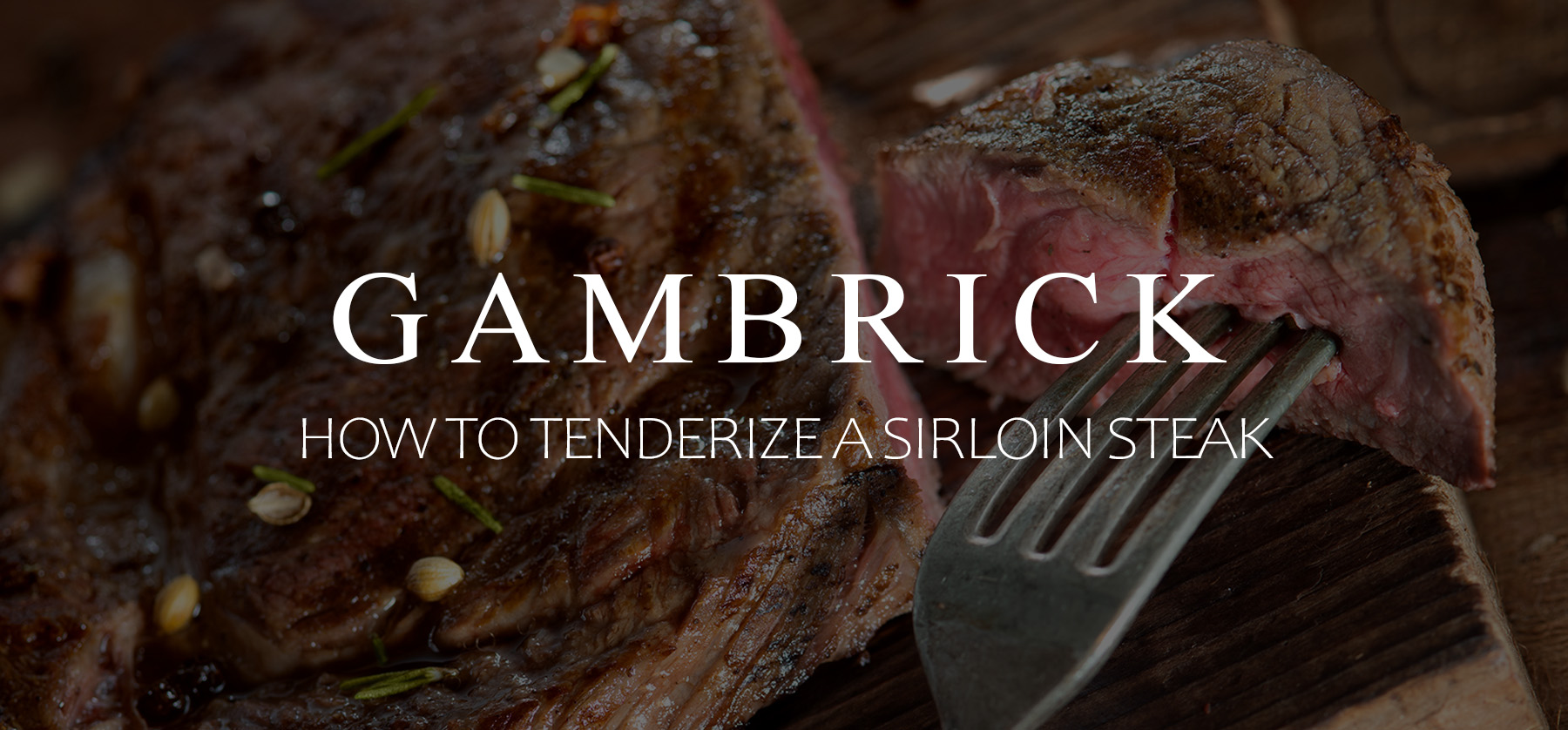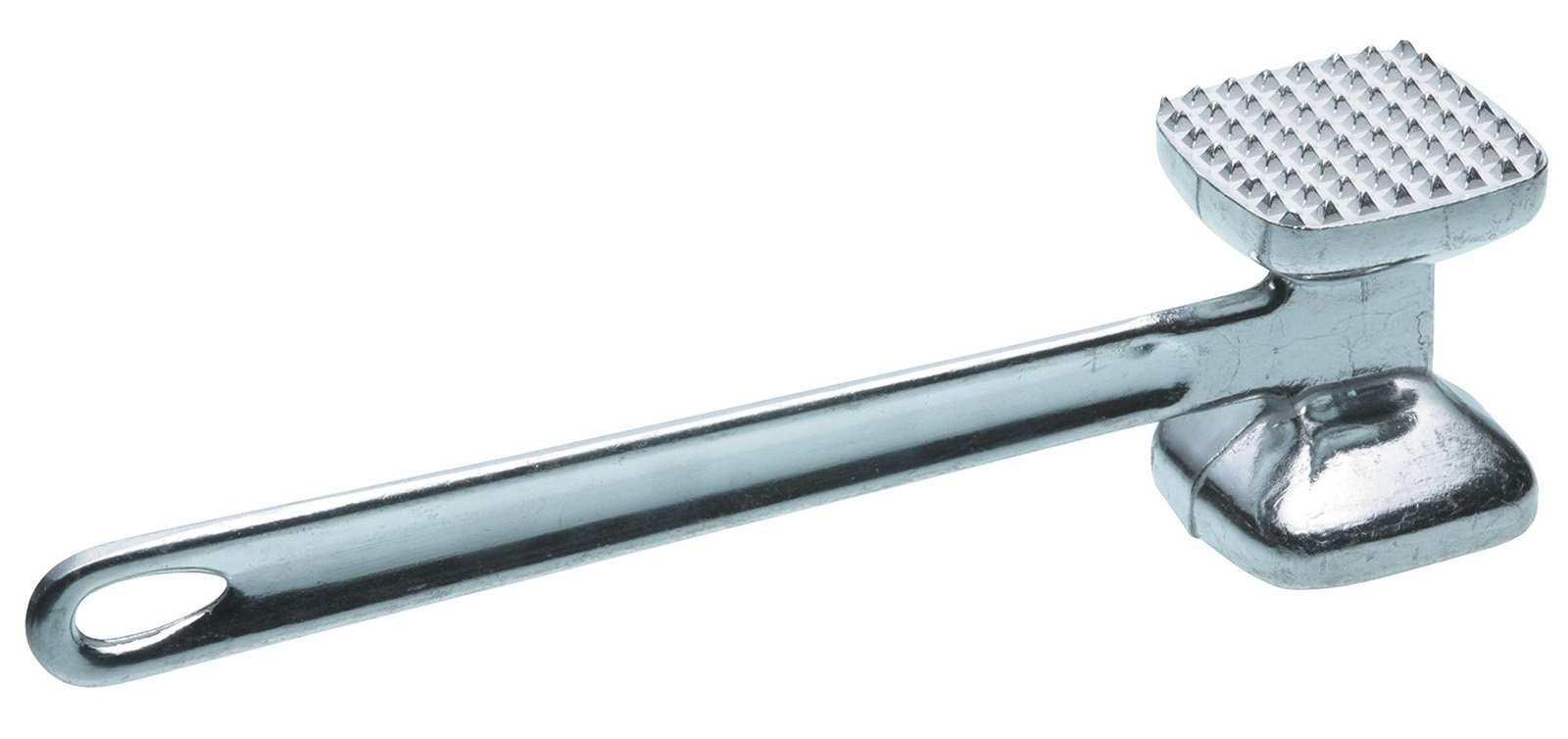How To Tenderize A Sirloin Steak
Sirloin steaks are cut from one of the two major subprimals of the beef loin primal cut. The primal cut runs from the 13th rib to the end of the hip bone of the cow. Butchers separate the meat into two steaks, the top butt and the bottom butt. Top sirloin steaks are lean and flavorful and usually cooked on the grill or in a skillet. While meat from the bottom butt is a great choice for roasting because its tougher. Top sirloin steaks are a juicy and fairly tender cut of beef with no bones and very little fat. Most sirloin steaks you buy at a restaurant are top sirloin. The best way to tenderize a sirloin steak is by pounding it with a mallet or marinading it in an acid based marinade. Both methods break down tough muscle fibers which tenderizes the meat.
Tenderizing a sirloin steak makes it easier to chew while maximizing its flavor. Most sirloins are fairly tender but it varies based on the age of the cow, how they were raised and what they were primarily fed. Although you could grill a sirloin without tenderizing it first they’re generally better if you do.
There are several techniques you can use to tenderize a sirloin steak, the best being a mallet or a good marinade. But the best results come from combining at least two methods because they tenderize a steak in different ways.
This article discusses the different step-by-step ways you can tenderize a sirloin steak.
What Makes Sirloin Steak Tough & Chewy?
Steaks are actually muscles cut from a cow. Muscles that get a lot of work are denser and have less fat marbling. This makes them tougher and harder to chew. But areas of a cow that don’t get much exercise are softer with more marbling. This makes the meat tender and flavorful.
Muscles at the top of the animal, around the backbone and ribs, don’t get much exercise so the meat is soft and tender with more marbling. These are your high-end cuts like prime rib, tenderloin, porterhouse, etc. Unfortunately these areas tend to be smaller so an entire cow only provides a few prime steaks. Hence the high price tag for the meat.
The working parts of the animal like the legs, neck and lower muscles get more exercise so the meat is tough and sinewy with more strips of fat and less marbling. There are more tough cuts on a cow than tender cuts so the price is much lower. These include chuck, brisket, skirt, etc.
Muscle is made up of long strings of connective tissue called fibers. Surrounding the muscle fibers are a thin gelatinous substance called collagen and fat.
Tenderizing beef before you cook it breaks down and weakens the fibers which makes the meat softer and more tender.
Now let’s take a look at the different ways to tenderize steak.
Buy A Spiked Meat Mallet Here On Amazon
Tenderize Sirloin Steak With A Mallet
Most sirloin steaks are fairly tender and juicy with good flavor. But it depends on the age of the cow, how they were raised and what they were fed. Sirloins are cut from an area of the cow that gets some exercise as it walks around and stands. This is why a sirloin steak could benefit from a little tenderizing before you cook.
The best way to tenderize a sirloin steak is by pounding it with a spiked mallet.
Repeatedly pound the beef very hard on both sides. This not only tenderizes the beef but also creates small dimples which allows rubs, spices, sauces and marinades to penetrate deeper into the meat.
If you’re worried about juices splashing off the steak as you hit it, place the steak in a large plastic bag. This will contain the juices as you tenderize the meat.
- The blunt force of the mallet helps break the bonds which hold muscle fibers together.
- Pounding the meat enhances the tenderizing effects of a marinade by opening up the beef’s muscle fibers. This allows flavors to penetrate deeper into the steak.
- If you use a spiked mallet, the spikes create small dimples for marinade to soak into.
As you pound the steak, tough muscle fibers are broken down and torn apart. This makes the beef softer, more tender and easier to chew. And it makes the beef taste better if you also use a marinade, rubs or sauces.
How To Tenderize Sirloin Steak With A Mallet
Use a good quality dish-washer-safe cutting board that’s well sanitized. I wrap the beef in some wax paper or plastic wrap to avoid cross contamination of surfaces. But you can tenderize the meat without wrapping it. Just make sure you clean up thoroughly afterwards.
Meat mallets come flat and spiked. The spiked end works better for tenderizing steaks. The flat side is better if you want to flatten the meat a little.
Hit the beef hard with the mallet but not too hard. You don’t want to damage the meat. Just soften it a little by creating dimples with the mallet.
As you hit the beef you’ll notice dimples on the surface from the mallet spikes. This means you’re breaking down and penetrating into the muscle fibers. When you’re all done, turn the steak over and do the same on the other side.
If you hit the steak too hard it’ll start to get slimmer. You don’t want this to happen because the meat can get tougher when it’s compressed. Just hit it hard enough to form some deep dimples and break up the muscle fibers a bit.
Once both sides are pounded you’re all done.
Remove the steak from the wax paper or plastic wrap and either cook it or place it in a marinade.
Tenderize Sirloin Steak With A Marinade
A great way to tenderize a sirloin steak is with an acidic marinade. Not just any marinade will tenderize a steak, it has to contain some acid like lemon, lime or kiwi. Fruit is actually a really good tenderizer because many contain acids.
Acids break down proteins and tough connective tissue which tenderizes the steak. Lemon juice, wine, vinegar, beer and soda are all strong tenderizers. Even liquids like buttermilk and yogurt will help tenderize meat because of their acidic qualities.
You can combine a tenderizing marinade with pounding the meat for an even more tender steak. Pounding the meat with the spiked edge of a mallet creates dimples which allow the marinade to penetrate deeper into the steak.
Marinade only tenderizes the surface of the meat it touches. So if you don’t pound the beef first you’ll only tenderize the outer edges with a marinade.
Here’s how you do it:
- Place your steak in a food-safe container and add your favorite marinade over it. This works better if you pound the meat with a spiked mallet first.
- Both sides of the steak should be bathed in marinade.
- Place the steak in the refrigerator.
- Let the steak rest for at least 30 minutes and no more than 24 hours. I recommend marinating for 8 hours.
- Remove the steak and start cooking.
Use a clean paper towel to blot the steak dry before cooking or grill it while still wet.
Pro Tip: When marinating with acids, use a non-reactive container like glass or Ziploc bags. A metal bowl can react with the acids giving your steak a strange metallic flavor.
Tenderize Sirloin Steak With Salt
Coating a sirloin steak with salt is another good way to tenderize it.
Don’t use regular table salt to tenderize a steak. It contains iodine which can give the meat a strange chemical flavor. It’s also too fine which makes it hard to wash off later. Table salt usually results in a weird tasting over salted steak. Use coarse kosher or sea salt instead.
You can use salt along with a pounding to tenderize a steak. The dimples created when you pound the meat allow the salt to penetrate deeper into the steak.
Tenderizing a sirloin steak with salt is easy, here’s how:
- Sprinkle coarse salt generously over both sides of the steak.
- Allow the steak to rest for at least an hour.
- Rinse off the excess salt.
- Dry the steak with a clean paper towel.
- Cook.
Salt draws out the steak’s natural juices which then dissolve the salt creating a brine solution. The brine then absorbs into the meat, adding in moisture while tenderizing.
In addition to tenderizing he meat, salting also gives it great flavor. Just remember not to add too much additional salt when you grill the meat. It’s easy to over salt a steak that’s already been tenderized in salt.
When you tenderize a steak with salt it will turn a little brown in color. Don’t be worried, this is normal and harmless.
Tenderize Sirloin Steak With An Enzyme Tenderizer
Natural enzymes are another good way to tenderize a sirloin steak while also adding some additional flavor.
You can also buy powdered meat tenderizer at the grocery store. Meat tenderizer contains a naturally derived enzyme powder. The enzyme most commonly used is papain, which comes from papayas or bromelain, which comes from pineapples. Sprinkle the steak with tenderizer and allow the enzymes to break down the meat fibers.
Meat tenderizing powder works fast. Usually the meat just has to sit with the powder on for a minute or two before cooking. The enzymes do most of the work while being cooked.
Use less salt on your steak if your enzyme-based tenderizer comes with salt in it.
If you prefer using fresh fruits instead of a powder, use a marinade of kiwis, pineapple, papaya and mango instead. These fruits are good sources of tenderizing enzymes and more natural than a powder.
The enzymes found in certain fruits do an excellent job of breaking down tough muscle fibers and connective tissue. They’ll tenderize the meat making it softer and less chewy.
Even though enzymes are effective, they only work on the meat’s surface. To make them more effective, pound the beef first with a spiked mallet. The dimples created by the mallet allow the enzymes to penetrate deeper into the meat.
When enzyme tenderizers are used too long the steak can get mushy on the outside.
- If you use the powder let it sit for just a minute or two before cooking.
- If you use the fruits let the steak marinade for about an hour.
Pro Tip: When marinating with enzymes, always use a non-reactive container like glass or Ziploc bags. A metal bowl can react with the enzymes giving your steak a strange metallic flavor.
Tenderize Sirloin Steak On The Grill
Slow-cooked meat is tenderized by hours of cooking at low temperatures. It can be achieved with dry heat on the grill or in the smoker. Or you can use wet heat where the meat is braised in liquid for several hours. Both methods produce a more tender steak.
When you slow cook steak, the collagen surrounding tough muscle fibers melts which breaks apart and loosens the muscle.
Slow cook a steak long enough and the meat will literally fall apart.
Heat and time are essential when slow cooking. But get the temperature wrong and the beef can actually get tougher and more dried out.
Below we’ll go over how to slow cook tenderize a sirloin steak in both dry and wet heat.
Dry Heat
Season your meat, and if you used a marinade, pat it dry with paper towels. Make sure the steak is dry before placing it on the grill.
Get the grill or smoker to around 225-250 °F before you place steaks on the grill. Once the steaks are in place let them sit and slowly cook. Slow cooking a steak is a great way to make the meat tender. The slower and longer you cook it, the softer it generally becomes. In some cases a sirloin can become so tender you can cut it with a fork.
Use a meat thermometer to check for an internal temperature of around 160 °F or higher. At this temperature the meat becomes moist and tender.
Cooking to a lower temperature than 160 °F, makes the collagen shrink and tighten which results in a dry and tough steak.
Once the internal temperature has reached 160°, check out the steak’s appearance and color. If the outside isn’t crisp and caramelized do a quick reverse sear on it.
Take the meat out to rest for a few minutes, then turn up the grill to 500+ °F and put the steak back on for a few minutes each side to sear the edges.
Wet Heat
Slow cooking a sirloin steak with wet heat can produce meat so tender it falls apart. It also creates some great tasting beef because you can create flavors not possible with dry heat. Try slow cooking your steaks with wine, spices, herbs and vegetables for even more flavor.
The key to this type of cooking is low heat for a long period of time.
Start by browning the meat on all sides over high heat in your Dutch oven or a cast iron skillet. This achieves a rich flavorful surface like the sear on a grill.
Remove the meat and deglaze the pan with liquid. Try wine, beer, broth or water. Add in your seasonings, veggies, onions, spices, potatoes, etc. Then put in the beef and cook with the lid on tight at around 300 °F for about 2.5 – 3 hours.
Make sure the lid stays on tight. If it’s open steam can release which dries out the meat.
Slow cooking in the oven generally works best, but a stovetop can also work as long as you keep the heat low and steady.
Tenderize A Sirloin Steak By Slicing It
The final way to improve the tenderness of a sirloin steak is done after you cook it. Once it’s off the grill and on the plate, cut it into thin slices. Thin slicing helps shorten tough muscle fibers making the meat a little softer and easier to chew.
Always cut steak against the grain. This makes the meat more tender and easier to chew.
Here are a few more tips that can help tenderize a steak:
- If your steak was stored in a freezer, bring it to room temperature before grilling.
- Rest your steak for at least 5 minutes before serving. The steak continues to cook while it rests and consolidates its juices.
Letting a steak rest and slicing it against the grain are the final things you can do to tenderize it before serving.
Final Words:
Pounding a sirloin steak to tenderize it generally works best. Especially when combined with another method like a marinade. I generally pick two methods depending on how I’ll be cooking the meat.
Do not over cook a steak. This can cause its muscle fibers to dry out and becoming tougher.
Summary: How To Tenderize A Sirloin Steak
Sirloin steaks are cut from one of the two major subprimals of the beef loin primal cut. The primal cut runs from the 13th rib to the end of the hip bone of the cow. Butchers separate the meat into two steaks, the top butt and the bottom butt. Top sirloin steaks are lean and flavorful and usually cooked on the grill or in a skillet. While meat from the bottom butt is a great choice for roasting because its tougher. Top sirloin steaks are a juicy and fairly tender cut of beef with no bones and very little fat. Most sirloin steaks you buy at a restaurant are top sirloin. The best way to tenderize a sirloin steak is by pounding it with a mallet or marinading it in an acid based marinade. Both methods break down tough muscle fibers which tenderizes the meat.
Tenderizing a sirloin steak makes it easier to chew but also maximizes flavor. Most sirloins are fairly tender but it varies based on the age of the cow, how they were raised and what they were primarily fed. Although you could grill a sirloin without tenderizing it first they’re generally better if you do.
There are several techniques you can use to tenderize a sirloin steak, the best being a mallet or a good marinade. But the best results come from combining at least two methods because they tenderize a steak in different ways.
If you have any questions about tenderizing steak, email any time.






















